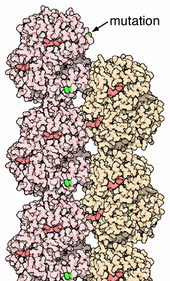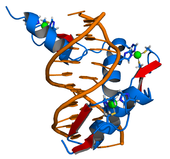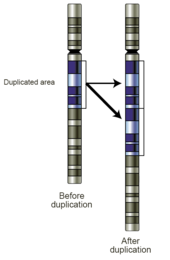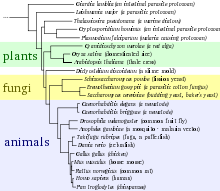- Genetics
-
This article is about the general scientific term. For the scientific journal, see Genetics (journal).
Part of a series on Genetics Key components Chromosome
DNA • RNA
Genome
Heredity
Mutation
Nucleotide
VariationHistory and topics Evolution • Molecular
Population genetics
Mendelian inheritance
Quantitative genetics
Molecular geneticsResearch DNA sequencing
Genetic engineering
Genomics • Topics
Medical geneticsBiology portal • For a generally accessible and less technical introduction to the topic, see Introduction to genetics.Genetics (from Ancient Greek γενετικός genetikos, "genitive" and that from γένεσις genesis, "origin"),[1][2][3] a discipline of biology, is the science of genes, heredity, and variation in living organisms.[4][5]
Genetics deals with the molecular structure and function of genes, with gene behavior in the context of a cell or organism (e.g. dominance and epigenetics), with patterns of inheritance from parent to offspring, and with gene distribution, variation and change in populations. Given that genes are universal to living organisms, genetics can be applied to the study of all living systems, from viruses and bacteria, through plants (especially crops) and domestic animals, to humans (as in medical genetics).
The fact that living things inherit traits from their parents has been used since prehistoric times to improve crop plants and animals through selective breeding. However, the modern science of genetics, which seeks to understand the process of inheritance, only began with the work of Gregor Mendel in the mid-19th century.[6] Although he did not know the physical basis for heredity, Mendel observed that organisms inherit traits via discrete units of inheritance, which are now called genes.
Genes correspond to regions within DNA, a molecule composed of a chain of four different types of nucleotides—the sequence of these nucleotides is the genetic information organisms inherit. DNA naturally occurs in a double stranded form, with nucleotides on each strand complementary to each other. Each strand can act as a template for creating a new partner strand. This is the physical method for making copies of genes that can be inherited.
The sequence of nucleotides in a gene is translated by cells to produce a chain of amino acids, creating proteins—the order of amino acids in a protein corresponds to the order of nucleotides in the gene. This relationship between nucleotide sequence and amino acid sequence is known as the genetic code. The amino acids in a protein determine how it folds into a three-dimensional shape; this structure is, in turn, responsible for the protein's function. Proteins carry out almost all the functions needed for cells to live. A change to the DNA in a gene can change a protein's amino acids, changing its shape and function: this can have a dramatic effect in the cell and on the organism as a whole.
Although genetics plays a large role in the appearance and behavior of organisms, it is the combination of genetics with what an organism experiences that determines the ultimate outcome. For example, while genes play a role in determining an organism's size, the nutrition and health it experiences after inception also have a large effect.
Contents
History
Main article: History of genetics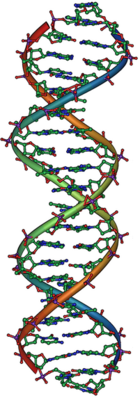 DNA, the molecular basis for inheritance. Each strand of DNA is a chain of nucleotides, matching each other in the center to form what look like rungs on a twisted ladder.
DNA, the molecular basis for inheritance. Each strand of DNA is a chain of nucleotides, matching each other in the center to form what look like rungs on a twisted ladder.
Although the science of genetics began with the applied and theoretical work of Gregor Mendel in the mid-19th century, other theories of inheritance preceded Mendel. A popular theory during Mendel's time was the concept of blending inheritance: the idea that individuals inherit a smooth blend of traits from their parents. Mendel's work disproved this, showing that traits are composed of combinations of distinct genes rather than a continuous blend. Another theory that had some support at that time was the inheritance of acquired characteristics: the belief that individuals inherit traits strengthened by their parents. This theory (commonly associated with Jean-Baptiste Lamarck) is now known to be wrong—the experiences of individuals do not affect the genes they pass to their children.[7] Other theories included the pangenesis of Charles Darwin (which had both acquired and inherited aspects) and Francis Galton's reformulation of pangenesis as both particulate and inherited.[8]
Mendelian and classical genetics
Modern genetics started with Gregor Johann Mendel, a German-Czech Augustinian monk and scientist who studied the nature of inheritance in plants. In his paper "Versuche über Pflanzenhybriden" ("Experiments on Plant Hybridization"), presented in 1865 to the Naturforschender Verein (Society for Research in Nature) in Brünn, Mendel traced the inheritance patterns of certain traits in pea plants and described them mathematically.[9] Although this pattern of inheritance could only be observed for a few traits, Mendel's work suggested that heredity was particulate, not acquired, and that the inheritance patterns of many traits could be explained through simple rules and ratios.
The importance of Mendel's work did not gain wide understanding until the 1890s, after his death, when other scientists working on similar problems re-discovered his research. William Bateson, a proponent of Mendel's work, coined the word genetics in 1905.[10][11] (The adjective genetic, derived from the Greek word genesis—γένεσις, "origin", predates the noun and was first used in a biological sense in 1860.)[12] Bateson popularized the usage of the word genetics to describe the study of inheritance in his inaugural address to the Third International Conference on Plant Hybridization in London, England, in 1906.[13]
After the rediscovery of Mendel's work, scientists tried to determine which molecules in the cell were responsible for inheritance. In 1910, Thomas Hunt Morgan argued that genes are on chromosomes, based on observations of a sex-linked white eye mutation in fruit flies.[14] In 1913, his student Alfred Sturtevant used the phenomenon of genetic linkage to show that genes are arranged linearly on the chromosome.[15]
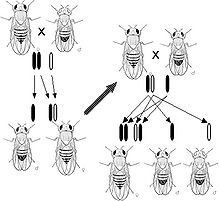 Morgan's observation of sex-linked inheritance of a mutation causing white eyes in Drosophila led him to the hypothesis that genes are located upon chromosomes.
Morgan's observation of sex-linked inheritance of a mutation causing white eyes in Drosophila led him to the hypothesis that genes are located upon chromosomes.
Molecular genetics
Although genes were known to exist on chromosomes, chromosomes are composed of both protein and DNA—scientists did not know which of these is responsible for inheritance. In 1928, Frederick Griffith discovered the phenomenon of transformation (see Griffith's experiment): dead bacteria could transfer genetic material to "transform" other still-living bacteria. Sixteen years later, in 1944, Oswald Theodore Avery, Colin McLeod and Maclyn McCarty identified the molecule responsible for transformation as DNA.[16] The Hershey-Chase experiment in 1952 also showed that DNA (rather than protein) is the genetic material of the viruses that infect bacteria, providing further evidence that DNA is the molecule responsible for inheritance.[17]
James D. Watson and Francis Crick determined the structure of DNA in 1953, using the X-ray crystallography work of Rosalind Franklin and Maurice Wilkins that indicated DNA had a helical structure (i.e., shaped like a corkscrew).[18][19] Their double-helix model had two strands of DNA with the nucleotides pointing inward, each matching a complementary nucleotide on the other strand to form what looks like rungs on a twisted ladder.[20] This structure showed that genetic information exists in the sequence of nucleotides on each strand of DNA. The structure also suggested a simple method for duplication: if the strands are separated, new partner strands can be reconstructed for each based on the sequence of the old strand.
Although the structure of DNA showed how inheritance works, it was still not known how DNA influences the behavior of cells. In the following years, scientists tried to understand how DNA controls the process of protein production. It was discovered that the cell uses DNA as a template to create matching messenger RNA (a molecule with nucleotides, very similar to DNA). The nucleotide sequence of a messenger RNA is used to create an amino acid sequence in protein; this translation between nucleotide and amino acid sequences is known as the genetic code.
With this molecular understanding of inheritance, an explosion of research became possible. One important development was chain-termination DNA sequencing in 1977 by Frederick Sanger. This technology allows scientists to read the nucleotide sequence of a DNA molecule.[21] In 1983, Kary Banks Mullis developed the polymerase chain reaction, providing a quick way to isolate and amplify a specific section of a DNA from a mixture.[22] Through the pooled efforts of the Human Genome Project and the parallel private effort by Celera Genomics, these and other methods culminated in the sequencing of the human genome in 2003.[23]
Features of inheritance
Discrete inheritance and Mendel's laws
Main article: Mendelian inheritanceAt its most fundamental level, inheritance in organisms occurs by means of discrete traits, called genes.[24] This property was first observed by Gregor Mendel, who studied the segregation of heritable traits in pea plants.[9][25] In his experiments studying the trait for flower color, Mendel observed that the flowers of each pea plant were either purple or white—but never an intermediate between the two colors. These different, discrete versions of the same gene are called alleles.
In the case of pea, which is a diploid species, each individual plant has two copies of each gene, one copy inherited from each parent.[26] Many species, including humans, have this pattern of inheritance. Diploid organisms with two copies of the same allele of a given gene are called homozygous at that gene locus, while organisms with two different alleles of a given gene are called heterozygous.
The set of alleles for a given organism is called its genotype, while the observable traits of the organism are called its phenotype. When organisms are heterozygous at a gene, often one allele is called dominant as its qualities dominate the phenotype of the organism, while the other allele is called recessive as its qualities recede and are not observed. Some alleles do not have complete dominance and instead have incomplete dominance by expressing an intermediate phenotype, or codominance by expressing both alleles at once.[27]
When a pair of organisms reproduce sexually, their offspring randomly inherit one of the two alleles from each parent. These observations of discrete inheritance and the segregation of alleles are collectively known as Mendel's first law or the Law of Segregation.
Notation and diagrams
Geneticists use diagrams and symbols to describe inheritance. A gene is represented by one or a few letters. Often a "+" symbol is used to mark the usual, non-mutant allele for a gene.[28]
In fertilization and breeding experiments (and especially when discussing Mendel's laws) the parents are referred to as the "P" generation and the offspring as the "F1" (first filial) generation. When the F1 offspring mate with each other, the offspring are called the "F2" (second filial) generation. One of the common diagrams used to predict the result of cross-breeding is the Punnett square.
When studying human genetic diseases, geneticists often use pedigree charts to represent the inheritance of traits.[29] These charts map the inheritance of a trait in a family tree.
Interactions of multiple genes
 Human height is a trait with complex genetic causes. Francis Galton's data from 1889 shows the relationship between offspring height as a function of mean parent height. While correlated, remaining variation in offspring heights indicates environment is also an important factor in this trait.
Human height is a trait with complex genetic causes. Francis Galton's data from 1889 shows the relationship between offspring height as a function of mean parent height. While correlated, remaining variation in offspring heights indicates environment is also an important factor in this trait.
Organisms have thousands of genes, and in sexually reproducing organisms these genes generally assort independently of each other. This means that the inheritance of an allele for yellow or green pea color is unrelated to the inheritance of alleles for white or purple flowers. This phenomenon, known as "Mendel's second law" or the "Law of independent assortment", means that the alleles of different genes get shuffled between parents to form offspring with many different combinations. (Some genes do not assort independently, demonstrating genetic linkage, a topic discussed later in this article.)
Often different genes can interact in a way that influences the same trait. In the Blue-eyed Mary (Omphalodes verna), for example, there exists a gene with alleles that determine the color of flowers: blue or magenta. Another gene, however, controls whether the flowers have color at all or are white. When a plant has two copies of this white allele, its flowers are white—regardless of whether the first gene has blue or magenta alleles. This interaction between genes is called epistasis, with the second gene epistatic to the first.[30]
Many traits are not discrete features (e.g. purple or white flowers) but are instead continuous features (e.g. human height and skin color). These complex traits are products of many genes.[31] The influence of these genes is mediated, to varying degrees, by the environment an organism has experienced. The degree to which an organism's genes contribute to a complex trait is called heritability.[32] Measurement of the heritability of a trait is relative—in a more variable environment, the environment has a bigger influence on the total variation of the trait. For example, human height is a trait with complex causes. It has a heritability of 89% in the United States. In Nigeria, however, where people experience a more variable access to good nutrition and health care, height has a heritability of only 62%.[33]
Molecular basis for inheritance
DNA and chromosomes
Main articles: DNA and Chromosome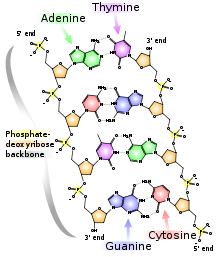 The molecular structure of DNA. Bases pair through the arrangement of hydrogen bonding between the strands.
The molecular structure of DNA. Bases pair through the arrangement of hydrogen bonding between the strands.
The molecular basis for genes is deoxyribonucleic acid (DNA). DNA is composed of a chain of nucleotides, of which there are four types: adenine (A), cytosine (C), guanine (G), and thymine (T). Genetic information exists in the sequence of these nucleotides, and genes exist as stretches of sequence along the DNA chain.[34] Viruses are the only exception to this rule—sometimes viruses use the very similar molecule RNA instead of DNA as their genetic material.[35]
DNA normally exists as a double-stranded molecule, coiled into the shape of a double-helix. Each nucleotide in DNA preferentially pairs with its partner nucleotide on the opposite strand: A pairs with T, and C pairs with G. Thus, in its two-stranded form, each strand effectively contains all necessary information, redundant with its partner strand. This structure of DNA is the physical basis for inheritance: DNA replication duplicates the genetic information by splitting the strands and using each strand as a template for synthesis of a new partner strand.[36]
Genes are arranged linearly along long chains of DNA base-pair sequences. In bacteria, each cell usually contains a single circular genophore, while eukaryotic organisms (including plants and animals) have their DNA arranged in multiple linear chromosomes. These DNA strands are often extremely long; the largest human chromosome, for example, is about 247 million base pairs in length.[37] The DNA of a chromosome is associated with structural proteins that organize, compact, and control access to the DNA, forming a material called chromatin; in eukaryotes, chromatin is usually composed of nucleosomes, segments of DNA wound around cores of histone proteins.[38] The full set of hereditary material in an organism (usually the combined DNA sequences of all chromosomes) is called the genome.
While haploid organisms have only one copy of each chromosome, most animals and many plants are diploid, containing two of each chromosome and thus two copies of every gene.[26] The two alleles for a gene are located on identical loci of sister chromatids, each allele inherited from a different parent.
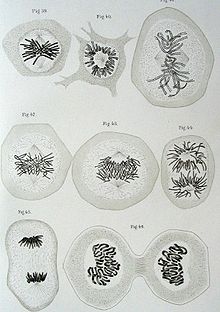 Walther Flemming's 1882 diagram of eukaryotic cell division. Chromosomes are copied, condensed, and organized. Then, as the cell divides, chromosome copies separate into the daughter cells.
Walther Flemming's 1882 diagram of eukaryotic cell division. Chromosomes are copied, condensed, and organized. Then, as the cell divides, chromosome copies separate into the daughter cells.
Many species have so called sex chromosomes. They are special in that they determine the sex of the organism.[39] In humans and many other animals, the Y-chromosome contains the gene that triggers the development of the specifically male characteristics. In evolution, this chromosome has lost most of its content and also most of its genes, while the X chromosome is similar to the other chromosomes and contains many genes. The X and Y chromosomes form a very heterogeneous pair before cell division.
Reproduction
Main articles: Asexual reproduction and Sexual reproductionWhen cells divide, their full genome is copied and each daughter cell inherits one copy. This process, called mitosis, is the simplest form of reproduction and is the basis for asexual reproduction. Asexual reproduction can also occur in multicellular organisms, producing offspring that inherit their genome from a single parent. Offspring that are genetically identical to their parents are called clones.
Eukaryotic organisms often use sexual reproduction to generate offspring that contain a mixture of genetic material inherited from two different parents. The process of sexual reproduction alternates between forms that contain single copies of the genome (haploid) and double copies (diploid).[26] Haploid cells fuse and combine genetic material to create a diploid cell with paired chromosomes. Diploid organisms form haploids by dividing, without replicating their DNA, to create daughter cells that randomly inherit one of each pair of chromosomes. Most animals and many plants are diploid for most of their lifespan, with the haploid form reduced to single cell gametes such as sperm or eggs.
Although they do not use the haploid/diploid method of sexual reproduction, bacteria have many methods of acquiring new genetic information. Some bacteria can undergo conjugation, transferring a small circular piece of DNA to another bacterium.[40] Bacteria can also take up raw DNA fragments found in the environment and integrate them into their genomes, a phenomenon known as transformation.[41] These processes result in horizontal gene transfer, transmitting fragments of genetic information between organisms that would be otherwise unrelated.
Recombination and linkage
Main articles: Chromosomal crossover and Genetic linkage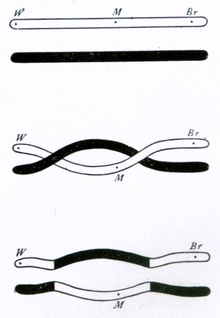 Thomas Hunt Morgan's 1916 illustration of a double crossover between chromosomes
Thomas Hunt Morgan's 1916 illustration of a double crossover between chromosomes
The diploid nature of chromosomes allows for genes on different chromosomes to assort independently during sexual reproduction, recombining to form new combinations of genes. Genes on the same chromosome would theoretically never recombine, however, were it not for the process of chromosomal crossover. During crossover, chromosomes exchange stretches of DNA, effectively shuffling the gene alleles between the chromosomes.[42] This process of chromosomal crossover generally occurs during meiosis, a series of cell divisions that creates haploid cells.
The probability of chromosomal crossover occurring between two given points on the chromosome is related to the distance between the points. For an arbitrarily long distance, the probability of crossover is high enough that the inheritance of the genes is effectively uncorrelated. For genes that are closer together, however, the lower probability of crossover means that the genes demonstrate genetic linkage—alleles for the two genes tend to be inherited together. The amounts of linkage between a series of genes can be combined to form a linear linkage map that roughly describes the arrangement of the genes along the chromosome.[43]
Gene expression
Genetic code
Main article: Genetic codeGenes generally express their functional effect through the production of proteins, which are complex molecules responsible for most functions in the cell. Proteins are made up of one or more polypeptide chains, each of which is composed of a sequence of amino acids, and the DNA sequence of a gene (through an RNA intermediate) is used to produce a specific amino acid sequence. This process begins with the production of an RNA molecule with a sequence matching the gene's DNA sequence, a process called transcription.
This messenger RNA molecule is then used to produce a corresponding amino acid sequence through a process called translation. Each group of three nucleotides in the sequence, called a codon, corresponds either to one of the twenty possible amino acids in a protein or an instruction to end the amino acic sequence; this correspondence is called the genetic code.[44] The flow of information is unidirectional: information is transferred from nucleotide sequences into the amino acid sequence of proteins, but it never transfers from protein back into the sequence of DNA—a phenomenon Francis Crick called the central dogma of molecular biology.[45]
The specific sequence of amino acids results in a unique three-dimensional structure for that protein, and the three-dimensional structures of proteins are related to their functions.[46][47] Some are simple structural molecules, like the fibers formed by the protein collagen. Proteins can bind to other proteins and simple molecules, sometimes acting as enzymes by facilitating chemical reactions within the bound molecules (without changing the structure of the protein itself). Protein structure is dynamic; the protein hemoglobin bends into slightly different forms as it facilitates the capture, transport, and release of oxygen molecules within mammalian blood.
A single nucleotide difference within DNA can cause a change in the amino acid sequence of a protein. Because protein structures are the result of their amino acid sequences, some changes can dramatically change the properties of a protein by destabilizing the structure or changing the surface of the protein in a way that changes its interaction with other proteins and molecules. For example, sickle-cell anemia is a human genetic disease that results from a single base difference within the coding region for the β-globin section of hemoglobin, causing a single amino acid change that changes hemoglobin's physical properties.[48] Sickle-cell versions of hemoglobin stick to themselves, stacking to form fibers that distort the shape of red blood cells carrying the protein. These sickle-shaped cells no longer flow smoothly through blood vessels, having a tendency to clog or degrade, causing the medical problems associated with this disease.
Some genes are transcribed into RNA but are not translated into protein products—such RNA molecules are called non-coding RNA. In some cases, these products fold into structures which are involved in critical cell functions (e.g. ribosomal RNA and transfer RNA). RNA can also have regulatory effect through hybridization interactions with other RNA molecules (e.g. microRNA).
Nature versus nurture
Main article: Nature vs. nurtureAlthough genes contain all the information an organism uses to function, the environment plays an important role in determining the ultimate phenotype—a phenomenon often referred to as "nature vs. nurture". The phenotype of an organism depends on the interaction of genetics with the environment. One example of this is the case of temperature-sensitive mutations. Often, a single amino acid change within the sequence of a protein does not change its behavior and interactions with other molecules, but it does destabilize the structure. In a high temperature environment, where molecules are moving more quickly and hitting each other, this results in the protein losing its structure and failing to function. In a low temperature environment, however, the protein's structure is stable and it functions normally. This type of mutation is visible in the coat coloration of Siamese cats, where a mutation in an enzyme responsible for pigment production causes it to destabilize and lose function at high temperatures.[49] The protein remains functional in areas of skin that are colder—legs, ears, tail, and face—and so the cat has dark fur at its extremities.
Environment also plays a dramatic role in effects of the human genetic disease phenylketonuria.[50] The mutation that causes phenylketonuria disrupts the ability of the body to break down the amino acid phenylalanine, causing a toxic build-up of an intermediate molecule that, in turn, causes severe symptoms of progressive mental retardation and seizures. If someone with the phenylketonuria mutation follows a strict diet that avoids this amino acid, however, they remain normal and healthy.
A popular method to determine how much role nature and nurture play is to study identical and fraternal twins or siblings of multiple birth.[citation needed] Because identical siblings come from the same zygote they are genetically the same. Fraternal siblings however are as different genetically from one another as normal siblings. By comparing how often the twin of a set has the same disorder between fraternal and identical twins, scientists can see whether there is more of a nature or nurture effect. One famous example of a multiple birth study includes the Genain quadruplets, who were identical quadruplets all diagnosed with schizophrenia.[51]
Gene regulation
Main article: Regulation of gene expressionThe genome of a given organism contains thousands of genes, but not all these genes need to be active at any given moment. A gene is expressed when it is being transcribed into mRNA (and translated into protein), and there exist many cellular methods of controlling the expression of genes such that proteins are produced only when needed by the cell. Transcription factors are regulatory proteins that bind to the start of genes, either promoting or inhibiting the transcription of the gene.[52] Within the genome of Escherichia coli bacteria, for example, there exists a series of genes necessary for the synthesis of the amino acid tryptophan. However, when tryptophan is already available to the cell, these genes for tryptophan synthesis are no longer needed. The presence of tryptophan directly affects the activity of the genes—tryptophan molecules bind to the tryptophan repressor (a transcription factor), changing the repressor's structure such that the repressor binds to the genes. The tryptophan repressor blocks the transcription and expression of the genes, thereby creating negative feedback regulation of the tryptophan synthesis process.[53]
Differences in gene expression are especially clear within multicellular organisms, where cells all contain the same genome but have very different structures and behaviors due to the expression of different sets of genes. All the cells in a multicellular organism derive from a single cell, differentiating into variant cell types in response to external and intercellular signals and gradually establishing different patterns of gene expression to create different behaviors. As no single gene is responsible for the development of structures within multicellular organisms, these patterns arise from the complex interactions between many cells.
Within eukaryotes there exist structural features of chromatin that influence the transcription of genes, often in the form of modifications to DNA and chromatin that are stably inherited by daughter cells.[54] These features are called "epigenetic" because they exist "on top" of the DNA sequence and retain inheritance from one cell generation to the next. Because of epigenetic features, different cell types grown within the same medium can retain very different properties. Although epigenetic features are generally dynamic over the course of development, some, like the phenomenon of paramutation, have multigenerational inheritance and exist as rare exceptions to the general rule of DNA as the basis for inheritance.[55]
Genetic change
Mutations
Main article: MutationDuring the process of DNA replication, errors occasionally occur in the polymerization of the second strand. These errors, called mutations, can have an impact on the phenotype of an organism, especially if they occur within the protein coding sequence of a gene. Error rates are usually very low—1 error in every 10–100 million bases—due to the "proofreading" ability of DNA polymerases.[56][57] (Without proofreading error rates are a thousandfold higher; because many viruses rely on DNA and RNA polymerases that lack proofreading ability, they experience higher mutation rates.) Processes that increase the rate of changes in DNA are called mutagenic: mutagenic chemicals promote errors in DNA replication, often by interfering with the structure of base-pairing, while UV radiation induces mutations by causing damage to the DNA structure.[58] Chemical damage to DNA occurs naturally as well, and cells use DNA repair mechanisms to repair mismatches and breaks in DNA—nevertheless, the repair sometimes fails to return the DNA to its original sequence.
In organisms that use chromosomal crossover to exchange DNA and recombine genes, errors in alignment during meiosis can also cause mutations.[59] Errors in crossover are especially likely when similar sequences cause partner chromosomes to adopt a mistaken alignment; this makes some regions in genomes more prone to mutating in this way. These errors create large structural changes in DNA sequence—duplications, inversions or deletions of entire regions, or the accidental exchanging of whole parts between different chromosomes (called translocation).
Natural selection and evolution
Main article: EvolutionFurther information: Natural selectionMutations alter an organisms genotype and occasionally this causes different phenotypes to appear. Most mutations have little effect on an organism's phenotype, health, or reproductive fitness. Mutations that do have an effect are usually deleterious, but occasionally some can be beneficial. Studies in the fly Drosophila melanogaster suggest that if a mutation changes a protein produced by a gene, about 70 percent of these mutations will be harmful with the remainder being either neutral or weakly beneficial.[60]
Population genetics studies the distribution of genetic differences within populations and how these distributions change over time.[61] Changes in the frequency of an allele in a population are mainly influenced by natural selection, where a given allele provides a selective or reproductive advantage to the organism,[62] as well as other factors such as mutation, genetic drift, genetic draft[63], artificial selection and migration.[64]
Over many generations, the genomes of organisms can change significantly, resulting in the phenomenon of evolution. Selection for beneficial mutations can cause a species to evolve into forms better able to survive in their environment, a process called adaptation.[65] New species are formed through the process of speciation, often caused by geographical separations that prevent populations from exchanging genes with each other.[66] The application of genetic principles to the study of population biology and evolution is referred to as the modern synthesis.
By comparing the homology between different species' genomes it is possible to calculate the evolutionary distance between them and when they may have diverged (called a molecular clock).[67] Genetic comparisons are generally considered a more accurate method of characterizing the relatedness between species than the comparison of phenotypic characteristics.[citation needed] The evolutionary distances between species can be used to form evolutionary trees; these trees represent the common descent and divergence of species over time, although they do not show the transfer of genetic material between unrelated species (known as horizontal gene transfer and most common in bacteria).
Research and technology
Model organisms
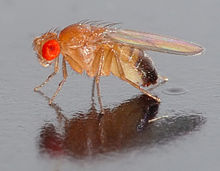 The common fruit fly (Drosophila melanogaster) is a popular model organism in genetics research.
The common fruit fly (Drosophila melanogaster) is a popular model organism in genetics research.
Although geneticists originally studied inheritance in a wide range of organisms, researchers began to specialize in studying the genetics of a particular subset of organisms. The fact that significant research already existed for a given organism would encourage new researchers to choose it for further study, and so eventually a few model organisms became the basis for most genetics research.[68] Common research topics in model organism genetics include the study of gene regulation and the involvement of genes in development and cancer.
Organisms were chosen, in part, for convenience—short generation times and easy genetic manipulation made some organisms popular genetics research tools. Widely used model organisms include the gut bacterium Escherichia coli, the plant Arabidopsis thaliana, baker's yeast (Saccharomyces cerevisiae), the nematode Caenorhabditis elegans, the common fruit fly (Drosophila melanogaster), and the common house mouse (Mus musculus).
Medicine
Medical genetics seeks to understand how genetic variation relates to human health and disease.[69] When searching for an unknown gene that may be involved in a disease, researchers commonly use genetic linkage and genetic pedigree charts to find the location on the genome associated with the disease. At the population level, researchers take advantage of Mendelian randomization to look for locations in the genome that are associated with diseases, a method especially useful for multigenic traits not clearly defined by a single gene.[70] Once a candidate gene is found, further research is often done on the corresponding gene (called an orthologous gene) in model organisms. In addition to studying genetic diseases, the increased availability of genotyping methods has led to the field of pharmacogenetics—studying how genotype can affect drug responses.[71]
Individuals differ in their inherited tendency to develop cancer,[72] and cancer is a genetic disease.[73] The process of cancer development in the body is a combination of events. Mutations occasionally occur within cells in the body as they divide. Although these mutations will not be inherited by any offspring, they can affect the behavior of cells, sometimes causing them to grow and divide more frequently. There are biological mechanisms that attempt to stop this process; signals are given to inappropriately dividing cells that should trigger cell death, but sometimes additional mutations occur that cause cells to ignore these messages. An internal process of natural selection occurs within the body and eventually mutations accumulate within cells to promote their own growth, creating a cancerous tumor that grows and invades various tissues of the body.
Normally, a cell divides only in response to signals: "growth factors", it stops growing when making contact with surrounding cells (contact inhibition), and in response to growth inhibitory signals, it divides a limited number of times and dies (apoptosis), it stays inside the epithelium and is not able to migrate to invade other organs. To become a cancer cell, a cell has to accumulate mutations in a number of genes (3-7) that allow it to bypass all these regulations: it no longer needs growth factors to divide, it continues growing when making contact to neighbor cells, and ignores inhibitory signals, it will keep growing indefinitely and is immortal, it will escape from the epithelium and ultimately may be able to escape from the primary tumor, cross the endothelium of a blood vessel, be transported by the bloodstream and will colonize a new organ, forming deadly metastasis. Although there are some genetic predispositions in a small fraction of cancers, the major fraction is due to a set of new genetic mutations that originally appear and accumulate in one or a small number of cells that will divide to form the tumor and are not transmitted to the progeny (somatic mutations). The most frequent mutations are a loss of function of p53 protein, a tumor suppressor, or in the p53 pathway, and gain of function mutations in the ras proteins, or in other oncogenes.
For human genetic diseases see Genetic Disorders.
Research methods
DNA can be manipulated in the laboratory. Restriction enzymes are commonly used enzymes that cut DNA at specific sequences, producing predictable fragments of DNA.[74] DNA fragments can be visualized through use of gel electrophoresis, which separates fragments according to their length.
The use of ligation enzymes allows DNA fragments to be connected, and by ligating fragments of DNA together from different sources, researchers can create recombinant DNA. Often associated with genetically modified organisms, recombinant DNA is commonly used in the context of plasmids—short circular DNA fragments with a few genes on them. By inserting plasmids into bacteria and growing those bacteria on plates of agar (to isolate clones of bacteria cells), researchers can clonally amplify the inserted fragment of DNA (a process known as molecular cloning). (Cloning can also refer to creating clonal organisms, by various means.)
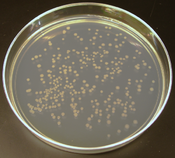 Colonies of E. coli on a plate of agar, an example of cellular cloning and often used in molecular cloning.
Colonies of E. coli on a plate of agar, an example of cellular cloning and often used in molecular cloning.
DNA can also be amplified using a procedure called the polymerase chain reaction (PCR).[75] By using specific short sequences of DNA, PCR can isolate and exponentially amplify a targeted region of DNA. Because it can amplify from extremely small amounts of DNA, PCR is also often used to detect the presence of specific DNA sequences.
DNA sequencing and genomics
One of the most fundamental technologies developed to study genetics, DNA sequencing allows researchers to determine the sequence of nucleotides in DNA fragments. Developed in 1977 by Frederick Sanger and coworkers, chain-termination sequencing is now routinely used to sequence DNA fragments.[76] With this technology, researchers have been able to study the molecular sequences associated with many human diseases.
As sequencing has become less expensive, researchers have sequenced the genomes of many organisms, using computational tools to stitch together the sequences of many different fragments (a process called genome assembly).[77] These technologies were used to sequence the human genome, leading to the completion of the Human Genome Project in 2003.[23] New high-throughput sequencing technologies are dramatically lowering the cost of DNA sequencing, with many researchers hoping to bring the cost of resequencing a human genome down to a thousand dollars.[78]
The large amount of sequence data available has created the field of genomics, research that uses computational tools to search for and analyze patterns in the full genomes of organisms. Genomics can also be considered a subfield of bioinformatics, which uses computational approaches to analyze large sets of biological data.
See also
- Genetic diseases
- Index of genetics articles
- Modern Evolution of Genetics Timeline
- Outline of genetics
Notes
- ^ Genetikos, Henry George Liddell, Robert Scott, "A Greek-English Lexicon", at Perseus
- ^ Genesis, Henry George Liddell, Robert Scott, "A Greek-English Lexicon", at Perseus
- ^ Online Etymology Dictionary
- ^ Griffiths, William M.; Miller, Jeffrey H.; Suzuki, David T. et al., eds (2000). "Genetics and the Organism: Introduction". An Introduction to Genetic Analysis (7th ed.). New York: W. H. Freeman. ISBN 0-7167-3520-2. http://www.ncbi.nlm.nih.gov/books/bv.fcgi?rid=iga.section.60.
- ^ Hartl D, Jones E (2005)
- ^ Weiling, F (1991). "Historical study: Johann Gregor Mendel 1822–1884.". American journal of medical genetics 40 (1): 1–25; discussion 26. doi:10.1002/ajmg.1320400103. PMID 1887835.
- ^ Lamarck, J-B (2008). In Encyclopædia Britannica. Retrieved from Encyclopædia Britannica Online on 16 March 2008.
- ^ Peter J. Bowler, The Mendelian Revolution: The Emergency of Hereditarian Concepts in Modern Science and Society (Baltimore: Johns Hopkins University Press, 1989): chapters 2 & 3.
- ^ a b Blumberg, Roger B.. "Mendel's Paper in English". http://www.mendelweb.org/Mendel.html.
- ^ genetics, n., Oxford English Dictionary, 3rd ed.
- ^ Bateson W. "Letter from William Bateson to Alan Sedgwick in 1905". The John Innes Centre. http://www.jic.ac.uk/corporate/about/bateson.htm. Retrieved 15 March 2008. Note that the letter was to an Adam Sedgwick, a zoologist and "Reader in Animal Morphology" at Trinity College, Cambridge
- ^ genetic, adj., Oxford English Dictionary, 3rd ed.
- ^ Bateson, W (1907). "The Progress of Genetic Research". In Wilks, W. Report of the Third 1906 International Conference on Genetics: Hybridization (the cross-breeding of genera or species), the cross-breeding of varieties, and general plant breeding. London: Royal Horticultural Society.
- Initially titled the "International Conference on Hybridisation and Plant Breeding", Wilks changed the title for publication as a result of Bateson's speech.[citation needed]
- ^ Moore, John A. (1983). "Thomas Hunt Morgan—The Geneticist". Integrative and Comparative Biology 23 (4): 855. doi:10.1093/icb/23.4.855.
- ^ Sturtevant AH (1913). "The linear arrangement of six sex-linked factors in Drosophila, as shown by their mode of association". Journal of Experimental Biology 14: 43–59. http://www.esp.org/foundations/genetics/classical/holdings/s/ahs-13.pdf.
- ^ Avery, OT; MacLeod, CM; McCarty, M (1944). "Studies on the Chemical Nature of the Substance Inducing Transformation of Pneumococcal Types: Induction of Transformation by a Desoxyribonucleic Acid Fraction Isolated from Pneumococcus Type III". The Journal of experimental medicine 79 (2): 137–58. doi:10.1084/jem.79.2.137. PMC 2135445. PMID 19871359. http://www.pubmedcentral.nih.gov/articlerender.fcgi?tool=pmcentrez&artid=2135445. Reprint: Avery, OT; Macleod, CM; Mccarty, M (1979). "Studies on the chemical nature of the substance inducing transformation of pneumococcal types. Inductions of transformation by a desoxyribonucleic acid fraction isolated from pneumococcus type III". The Journal of experimental medicine 149 (2): 297–326. doi:10.1084/jem.149.2.297. PMC 2184805. PMID 33226. http://www.pubmedcentral.nih.gov/articlerender.fcgi?tool=pmcentrez&artid=2184805.
- ^ Hershey, AD; Chase, M (1952). "Independent functions of viral protein and nucleic acid in growth of bacteriophage". The Journal of general physiology 36 (1): 39–56. doi:10.1085/jgp.36.1.39. PMC 2147348. PMID 12981234. http://www.pubmedcentral.nih.gov/articlerender.fcgi?tool=pmcentrez&artid=2147348.
- ^ Judson, Horace (1979). The Eighth Day of Creation: Makers of the Revolution in Biology. Cold Spring Harbor Laboratory Press. pp. 51–169. ISBN 0-87969-477-7.
- ^ Watson, J. D.; Crick, FH (1953). "Molecular Structure of Nucleic Acids: A Structure for Deoxyribose Nucleic Acid". Nature 171 (4356): 737–8. Bibcode 1953Natur.171..737W. doi:10.1038/171737a0. PMID 13054692. http://www.nature.com/nature/dna50/watsoncrick.pdf.
- ^ Watson, J. D.; Crick, FH (1953). "Genetical Implications of the Structure of Deoxyribonucleic Acid". Nature 171 (4361): 964–7. Bibcode 1953Natur.171..964W. doi:10.1038/171964b0. PMID 13063483. http://www.nature.com/nature/dna50/watsoncrick2.pdf.
- ^ Sanger, F; Nicklen, S; Coulson, AR (1977). "DNA sequencing with chain-terminating inhibitors". Proceedings of the National Academy of Sciences of the United States of America 74 (12): 5463–7. doi:10.1073/pnas.74.12.5463. PMC 431765. PMID 271968. http://www.pubmedcentral.nih.gov/articlerender.fcgi?tool=pmcentrez&artid=431765.
- ^ Saiki, RK; Scharf, S; Faloona, F; Mullis, KB; Horn, GT; Erlich, HA; Arnheim, N (1985). "Enzymatic amplification of beta-globin genomic sequences and restriction site analysis for diagnosis of sickle cell anemia". Science 230 (4732): 1350–4. doi:10.1126/science.2999980. PMID 2999980.
- ^ a b "Human Genome Project Information". Human Genome Project. http://www.ornl.gov/sci/techresources/Human_Genome/home.shtml. Retrieved 15 March 2008.
- ^ Griffiths, William M.; Miller, Jeffrey H.; Suzuki, David T. et al., eds (2000). "Patterns of Inheritance: Introduction". An Introduction to Genetic Analysis (7th ed.). New York: W. H. Freeman. ISBN 0-7167-3520-2. http://www.ncbi.nlm.nih.gov/books/bv.fcgi?rid=iga.section.199.
- ^ Griffiths, William M.; Miller, Jeffrey H.; Suzuki, David T. et al., eds (2000). "Mendel's experiments". An Introduction to Genetic Analysis (7th ed.). New York: W. H. Freeman. ISBN 0-7167-3520-2. http://www.ncbi.nlm.nih.gov/books/bv.fcgi?rid=iga.section.200.
- ^ a b c Griffiths, William M.; Miller, Jeffrey H.; Suzuki, David T. et al., eds (2000). "Mendelian genetics in eukaryotic life cycles". An Introduction to Genetic Analysis (7th ed.). New York: W. H. Freeman. ISBN 0-7167-3520-2. http://www.ncbi.nlm.nih.gov/books/bv.fcgi?rid=iga.section.484.
- ^ Griffiths, William M.; Miller, Jeffrey H.; Suzuki, David T. et al., eds (2000). "Interactions between the alleles of one gene". An Introduction to Genetic Analysis (7th ed.). New York: W. H. Freeman. ISBN 0-7167-3520-2. http://www.ncbi.nlm.nih.gov/books/bv.fcgi?rid=iga.section.630.
- ^ Cheney, Richard W.. "Genetic Notation". http://faculty.users.cnu.edu/rcheney/Genetic%20Notation.htm. Retrieved 18 March 2008.
- ^ Griffiths, William M.; Miller, Jeffrey H.; Suzuki, David T. et al., eds (2000). "Human Genetics". An Introduction to Genetic Analysis (7th ed.). New York: W. H. Freeman. ISBN 0-7167-3520-2. http://www.ncbi.nlm.nih.gov/books/bv.fcgi?rid=iga.section.229.
- ^ Griffiths, William M.; Miller, Jeffrey H.; Suzuki, David T. et al., eds (2000). "Gene interaction and modified dihybrid ratios". An Introduction to Genetic Analysis (7th ed.). New York: W. H. Freeman. ISBN 0-7167-3520-2. http://www.ncbi.nlm.nih.gov/books/bv.fcgi?rid=iga.section.644.
- ^ Mayeux, R (2005). "Mapping the new frontier: complex genetic disorders". The Journal of clinical investigation 115 (6): 1404–7. doi:10.1172/JCI25421. PMC 1137013. PMID 15931374. http://www.pubmedcentral.nih.gov/articlerender.fcgi?tool=pmcentrez&artid=1137013.
- ^ Griffiths, William M.; Miller, Jeffrey H.; Suzuki, David T. et al., eds (2000). "Quantifying heritability". An Introduction to Genetic Analysis (7th ed.). New York: W. H. Freeman. ISBN 0-7167-3520-2. http://www.ncbi.nlm.nih.gov/books/bv.fcgi?rid=iga.section.4009.
- ^ Luke, A; Guo, X; Adeyemo, AA; Wilks, R; Forrester, T; Lowe W, W; Comuzzie, AG; Martin, LJ et al. (2001). "Heritability of obesity-related traits among Nigerians, Jamaicans and US black people". International journal of obesity and related metabolic disorders 25 (7): 1034–41. doi:10.1038/sj.ijo.0801650. PMID 11443503.
- ^ Pearson, H (2006). "Genetics: what is a gene?". Nature 441 (7092): 398–401. doi:10.1038/441398a. PMID 16724031.
- ^ Prescott, L (1993). Microbiology. Wm. C. Brown Publishers. ISBN 0-697-01372-3.
- ^ Griffiths, William M.; Miller, Jeffrey H.; Suzuki, David T. et al., eds (2000). "Mechanism of DNA Replication". An Introduction to Genetic Analysis (7th ed.). New York: W. H. Freeman. ISBN 0-7167-3520-2. http://www.ncbi.nlm.nih.gov/books/bv.fcgi?rid=iga.section.1523.
- ^ Gregory, SG; Barlow, KF; Mclay, KE; Kaul, R; Swarbreck, D; Dunham, A; Scott, CE; Howe, KL et al. (2006). "The DNA sequence and biological annotation of human chromosome 1". Nature 441 (7091): 315–21. doi:10.1038/nature04727. PMID 16710414.
- ^ Alberts et al. (2002), II.4. DNA and chromosomes: Chromosomal DNA and Its Packaging in the Chromatin Fiber
- ^ Griffiths, William M.; Miller, Jeffrey H.; Suzuki, David T. et al., eds (2000). "Sex chromosomes and sex-linked inheritance". An Introduction to Genetic Analysis (7th ed.). New York: W. H. Freeman. ISBN 0-7167-3520-2. http://www.ncbi.nlm.nih.gov/books/bv.fcgi?rid=iga.section.222.
- ^ Griffiths, William M.; Miller, Jeffrey H.; Suzuki, David T. et al., eds (2000). "Bacterial conjugation". An Introduction to Genetic Analysis (7th ed.). New York: W. H. Freeman. ISBN 0-7167-3520-2. http://www.ncbi.nlm.nih.gov/books/bv.fcgi?rid=iga.section.1304.
- ^ Griffiths, William M.; Miller, Jeffrey H.; Suzuki, David T. et al., eds (2000). "Bacterial transformation". An Introduction to Genetic Analysis (7th ed.). New York: W. H. Freeman. ISBN 0-7167-3520-2. http://www.ncbi.nlm.nih.gov/books/bv.fcgi?rid=iga.section.1343.
- ^ Griffiths, William M.; Miller, Jeffrey H.; Suzuki, David T. et al., eds (2000). "Nature of crossing-over". An Introduction to Genetic Analysis (7th ed.). New York: W. H. Freeman. ISBN 0-7167-3520-2. http://www.ncbi.nlm.nih.gov/books/bv.fcgi?rid=iga.section.929.
- ^ Griffiths, William M.; Miller, Jeffrey H.; Suzuki, David T. et al., eds (2000). "Linkage maps". An Introduction to Genetic Analysis (7th ed.). New York: W. H. Freeman. ISBN 0-7167-3520-2. http://www.ncbi.nlm.nih.gov/books/bv.fcgi?rid=iga.section.899.
- ^ Berg JM, Tymoczko JL, Stryer L, Clarke ND (2002). "I. 5. DNA, RNA, and the Flow of Genetic Information: Amino Acids Are Encoded by Groups of Three Bases Starting from a Fixed Point". Biochemistry (5th ed.). New York: W. H. Freeman and Company. http://www.ncbi.nlm.nih.gov/books/bv.fcgi?rid=stryer.section.685.
- ^ Crick, F (1970). "Central dogma of molecular biology". Nature 227 (5258): 561–3. Bibcode 1970Natur.227..561C. doi:10.1038/227561a0. PMID 4913914. http://www.nature.com/nature/focus/crick/pdf/crick227.pdf.
- ^ Alberts et al. (2002), I.3. Proteins: The Shape and Structure of Proteins
- ^ Alberts et al. (2002), I.3. Proteins: Protein Function
- ^ "How Does Sickle Cell Cause Disease?". Brigham and Women's Hospital: Information Center for Sickle Cell and Thalassemic Disorders. 11 April 2002. http://sickle.bwh.harvard.edu/scd_background.html. Retrieved 23 July 2007.
- ^ Imes, DL; Geary, LA; Grahn, RA; Lyons, LA (2006). "Albinism in the domestic cat (Felis catus) is associated with a tyrosinase (TYR) mutation". Animal genetics 37 (2): 175–8. doi:10.1111/j.1365-2052.2005.01409.x. PMC 1464423. PMID 16573534. http://www.pubmedcentral.nih.gov/articlerender.fcgi?tool=pmcentrez&artid=1464423.
- ^ "MedlinePlus: Phenylketonuria". NIH: National Library of Medicine. http://www.nlm.nih.gov/medlineplus/phenylketonuria.html. Retrieved 15 March 2008.
- ^ Rosenthal, David (1964). The Genain quadruplets; a case study and theoretical analysis of heredity and environment in schizophrenia.. New York: Basic Books. ISBN B0000CM68F.
- ^ Brivanlou, AH; Darnell Je, JE (2002). "Signal transduction and the control of gene expression". Science 295 (5556): 813–8. doi:10.1126/science.1066355. PMID 11823631.
- ^ Alberts et al. (2002), II.3. Control of Gene Expression – The Tryptophan Repressor Is a Simple Switch That Turns Genes On and Off in Bacteria
- ^ Jaenisch, R; Bird, A (2003). "Epigenetic regulation of gene expression: how the genome integrates intrinsic and environmental signals". Nature genetics 33 Suppl (3s): 245–54. doi:10.1038/ng1089. PMID 12610534.
- ^ Chandler, VL (2007). "Paramutation: from maize to mice". Cell 128 (4): 641–5. doi:10.1016/j.cell.2007.02.007. PMID 17320501.
- ^ Griffiths, William M.; Miller, Jeffrey H.; Suzuki, David T. et al., eds (2000). "Spontaneous mutations". An Introduction to Genetic Analysis (7th ed.). New York: W. H. Freeman. ISBN 0-7167-3520-2. http://www.ncbi.nlm.nih.gov/books/bv.fcgi?rid=iga.section.2706.
- ^ Freisinger, E; Grollman, AP; Miller, H; Kisker, C (2004). "Lesion (in)tolerance reveals insights into DNA replication fidelity". The EMBO journal 23 (7): 1494–505. doi:10.1038/sj.emboj.7600158. PMC 391067. PMID 15057282. http://www.pubmedcentral.nih.gov/articlerender.fcgi?tool=pmcentrez&artid=391067.
- ^ Griffiths, William M.; Miller, Jeffrey H.; Suzuki, David T. et al., eds (2000). "Induced mutations". An Introduction to Genetic Analysis (7th ed.). New York: W. H. Freeman. ISBN 0-7167-3520-2. http://www.ncbi.nlm.nih.gov/books/bv.fcgi?rid=iga.section.2727.
- ^ Griffiths, William M.; Miller, Jeffrey H.; Suzuki, David T. et al., eds (2000). "Chromosome Mutation I: Changes in Chromosome Structure: Introduction". An Introduction to Genetic Analysis (7th ed.). New York: W. H. Freeman. ISBN 0-7167-3520-2. http://www.ncbi.nlm.nih.gov/books/bv.fcgi?rid=iga.section.2844.
- ^ Sawyer, SA; Parsch, J; Zhang, Z; Hartl, DL (2007). "Prevalence of positive selection among nearly neutral amino acid replacements in Drosophila". Proceedings of the National Academy of Sciences of the United States of America 104 (16): 6504–10. doi:10.1073/pnas.0701572104. PMC 1871816. PMID 17409186. http://www.pubmedcentral.nih.gov/articlerender.fcgi?tool=pmcentrez&artid=1871816.
- ^ Griffiths, William M.; Miller, Jeffrey H.; Suzuki, David T. et al., eds (2000). "Variation and its modulation". An Introduction to Genetic Analysis (7th ed.). New York: W. H. Freeman. ISBN 0-7167-3520-2. http://www.ncbi.nlm.nih.gov/books/bv.fcgi?rid=iga.section.3842.
- ^ Griffiths, William M.; Miller, Jeffrey H.; Suzuki, David T. et al., eds (2000). "Selection". An Introduction to Genetic Analysis (7th ed.). New York: W. H. Freeman. ISBN 0-7167-3520-2. http://www.ncbi.nlm.nih.gov/books/bv.fcgi?rid=iga.section.3886.
- ^ Gillespie, John H. (2001). "Is the population size of a species relevant to its evolution?". Evolution 55 (11): 2161–2169. PMID 11794777.
- ^ Griffiths, William M.; Miller, Jeffrey H.; Suzuki, David T. et al., eds (2000). "Random events". An Introduction to Genetic Analysis (7th ed.). New York: W. H. Freeman. ISBN 0-7167-3520-2. http://www.ncbi.nlm.nih.gov/books/bv.fcgi?rid=iga.section.3906.
- ^ Darwin, Charles (1859). On the Origin of Species (1st ed.). London: John Murray. pp. 1. ISBN 0-8014-1319-2. http://darwin-online.org.uk/content/frameset?itemID=F373&viewtype=text&pageseq=16. Related earlier ideas were acknowledged in Darwin, Charles (1861). On the Origin of Species (3rd ed.). London: John Murray. xiii. ISBN 0-8014-1319-2. http://darwin-online.org.uk/content/frameset?itemID=F381&viewtype=text&pageseq=20.
- ^ Gavrilets, S (2003). "Perspective: models of speciation: what have we learned in 40 years?". Evolution; international journal of organic evolution 57 (10): 2197–215. doi:10.1554/02-727. PMID 14628909.
- ^ Wolf, YI; Rogozin, IB; Grishin, NV; Koonin, EV (2002). "Genome trees and the tree of life". Trends in genetics 18 (9): 472–9. doi:10.1016/S0168-9525(02)02744-0. PMID 12175808.
- ^ "The Use of Model Organisms in Instruction". University of Wisconsin: Wisconsin Outreach Research Modules. http://www.loci.wisc.edu/outreach/text/model.html. Retrieved 15 March 2008.
- ^ "NCBI: Genes and Disease". NIH: National Center for Biotechnology Information. http://www.ncbi.nlm.nih.gov/books/bv.fcgi?rid=gnd&ref=sidebar. Retrieved 15 March 2008.
- ^ Davey Smith, G; Ebrahim, S (2003). "'Mendelian randomization': can genetic epidemiology contribute to understanding environmental determinants of disease?". International journal of epidemiology 32 (1): 1–22. doi:10.1093/ije/dyg070. PMID 12689998.
- ^ "Pharmacogenetics Fact Sheet". NIH: National Institute of General Medical Sciences. http://www.nigms.nih.gov/Initiatives/PGRN/Background/FactSheet.htm. Retrieved 15 March 2008.
- ^ Frank, SA (2004). "Genetic predisposition to cancer – insights from population genetics". Nature reviews. Genetics 5 (10): 764–72. doi:10.1038/nrg1450. PMID 15510167.
- ^ Strachan T, Read AP (1999). Human Molecular Genetics 2 (second ed.). John Wiley & Sons Inc..Chapter 18: Cancer Genetics
- ^ Lodish et al. (2000), Chapter 7: 7.1. DNA Cloning with Plasmid Vectors
- ^ Lodish et al. (2000), Chapter 7: 7.7. Polymerase Chain Reaction: An Alternative to Cloning
- ^ Brown TA (2002). "Section 2, Chapter 6: 6.1. The Methodology for DNA Sequencing". Genomes 2 (2nd ed.). Oxford: Bios. ISBN 1-85996-228-9. http://www.ncbi.nlm.nih.gov/books/bv.fcgi?rid=genomes.section.6452.
- ^ Brown (2002), Section 2, Chapter 6: 6.2. Assembly of a Contiguous DNA Sequence
- ^ Service, RF (2006). "Gene sequencing. The race for the $1000 genome". Science 311 (5767): 1544–6. doi:10.1126/science.311.5767.1544. PMID 16543431.
References
- Alberts B, Johnson A, Lewis J, Raff M, Roberts K, and Walter P (2002). Molecular Biology of the Cell (4th ed.). New York: Garland Science. ISBN 0-8153-3218-1.
- Griffiths, William M.; Miller, Jeffrey H.; Suzuki, David T. et al., eds (2000). An Introduction to Genetic Analysis (7th ed.). New York: W. H. Freeman. ISBN 0-7167-3520-2.
- Hartl D, Jones E (2005). Genetics: Analysis of Genes and Genomes (6th ed.). Jones & Bartlett. ISBN 0-7637-1511-5.
- Lodish H, Berk A, Zipursky LS, Matsudaira P, Baltimore D, and Darnell J (2000). Molecular Cell Biology (4th ed.). New York: Scientific American Books. ISBN 0-7167-3136-3.
External links
- Genetics on In Our Time at the BBC. (listen now)
- Genetics at the Open Directory Project
Genetics Key components Fields of genetics Archaeogenetics of... Related topics Geneticist · Genomics · Genetic code · Medical genetics · Molecular evolution · Reverse genetics · Genetic engineering · Genetic diversity · Heredity · Genetic monitoringCategories:- Articles with separate introductions
- Genetics
- Subjects taught in medical school
- Greek loanwords
Wikimedia Foundation. 2010.




